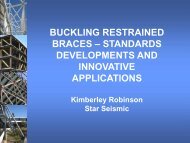Environmental Impacts of Multi-Storey Buildings Using Different ...
Environmental Impacts of Multi-Storey Buildings Using Different ...
Environmental Impacts of Multi-Storey Buildings Using Different ...
You also want an ePaper? Increase the reach of your titles
YUMPU automatically turns print PDFs into web optimized ePapers that Google loves.
- 42 -comparison to the much larger variations in operational energy between the differentbuildings (Cole and Kernan (1996); Page (2006); Sartori and Hestnes (2007); Suzuki and Oka(1998)).Similar operational energy consumption <strong>of</strong> the four buildings being compared in this reportmeans that the differences in the environmental impacts are determined by the differences inthe embodied and recurrent (maintenance and refurbishment) energy and GWP emissions inthe different materials used in each building.To achieve very similar operational energy pr<strong>of</strong>iles required different design for envelopewalls construction, thermal mass, and heating and cooling equipment in each <strong>of</strong> the fourbuildings.An energy performance simulation was undertaken to assess the operational energy use <strong>of</strong> allfour building. The energy simulation was initially undertaken for the Concrete building usingDesign Builder s<strong>of</strong>tware (2008). Design parameters were varied, trialling differentequipment, materials and data sets until a satisfactory operational energy pr<strong>of</strong>ile wasachieved; a pr<strong>of</strong>ile typical <strong>of</strong> a multi-storey <strong>of</strong>fice building in Christchurch.This energy consumption pr<strong>of</strong>ile was then used as a benchmark energy target for thealternative Steel, Timber and TimberPlus buildings. Iterative energy simulations followingchanges in design features (for example, selection <strong>of</strong> improvement in envelope wallsconstruction and some changes in finishes) were undertaken with each <strong>of</strong> the alternativebuildings, aiming to reach the benchmark set by the Concrete building. Once the ‘Concrete’benchmark was reached, final simulations were carried out to assess the small differencesbetween the energy performances <strong>of</strong> each <strong>of</strong> the four buildings.5.2 Operational Energy Simulation5.2.1 Simulation MethodThe Concrete building was designed initially to have low energy consumption, and to performbetter than the minimum requirements <strong>of</strong> New Zealand Standard NZS 4243 Energy Efficiency– Large <strong>Buildings</strong> (NZS). Subsequently, all four buildings in this research had similarperformance pr<strong>of</strong>iles (close to 86 kWh/m 2 /year). This is particularly important because one<strong>of</strong> the aims <strong>of</strong> this research was to look at the influence <strong>of</strong> materials on the life cycle energyuse and GWP emissions <strong>of</strong> the buildings.For the simulations carried out in this study, many <strong>of</strong> the inputs (Table 5.1) are default databased on NZS 4243 but some data from the Design Builder s<strong>of</strong>tware library database was alsoused as input (NZS (1996)). A Wellington based engineering company eCubed BuildingWorkshop Ltd 2 was involved to supervise the simulation process.2 2 e-Cubed Building Workshop Ltd. synthesises traditional mechanical and electrical services engineeringdesign with new trends in sustainable design. Service is based upon an extensive local and international trackrecord in applying sustainable principles to engineering services design. The e-Cubed sustainable design serviceworks alongside the architect and the traditional engineering consultants to develop a sustainable designframework and concepts which are refined and tested by the use <strong>of</strong> advanced modeling tools with the aim <strong>of</strong>reducing energy and water use by 40-50% when compared to a conventional solution.
















